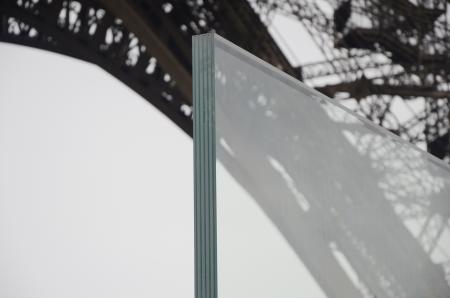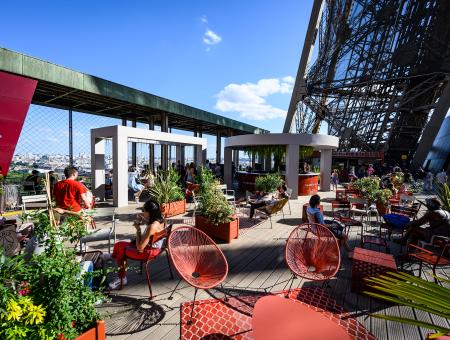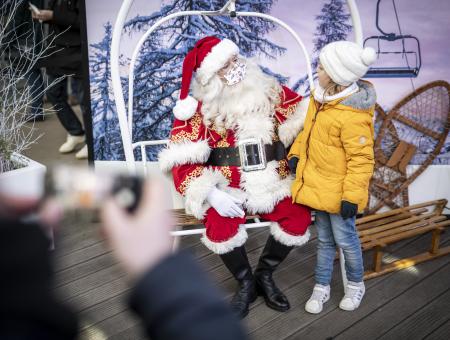“This year, the Eiffel Tower is beginning a new chapter in its history; it intends to provide the services that visitors expect from the most emblematic monument in Paris,” explains Anne Yannic, Executive Director of SETE. “Our project is ambitious: its purpose is to improve the appearance of the Tower while offering a brand new experience, at a point when the city is preparing to host a series of major international events, starting off with the Olympic Games.”
New entrance points and a perimeter that now includes the gardens
The 15-year Délégation de Service Public (DSP, delegation of public service) granted by the City of Paris to the SETE – in effect since 1 November 2017 – has expanded the perimeter of the Eiffel Tower site in order to showcase the beautiful gardens and give visitors the opportunity to discover the site in its entirety. The area open to visitors now includes the side gardens, up to allées Léon Bourgeois and Paul Deschanel.
Since March 2018, visitors have paid at the entrance after passing through the original gardens surrounding the monument, which are listed as protected wooded areas (EBC, Espaces Boisés Classés). They have been redesigned to provide visitors with a new experience and to afford a unique viewing perspective on the monument. Access to the gardens and forecourt is free.
In this area, glass security booths have been set up along the bridle paths of the East-West axis. After entering the site, visitors can stroll along on the paths protected by a “stabilised” covering, through beautiful, peaceful gardens; more than 2 hectares of vegetation surrounded by metal wire made of Corten steel (a material that can withstand atmospheric conditions), reaching 3.24 metres in height, which has been specially created for the Eiffel Tower, and whose shape is inspired by the design of the monument. The area is also home to hundred-year-old trees, around 2,000 shrubs, 20,000 perennials, and much more. Visitors can wander through the gardens to (re)discover the romantic spirit of the place, as well as some new perspectives – known as cones of vision – which had long been forgotten.
By July 2018, street furniture will also be set up in the area. The beautiful green spaces are further enhanced by the reconstruction of two ponds, and the refurbishment of the rocky water feature.
The glass wall, the highlight of the project to improve security around the monument
Alongside the landscaped entrance pathways, a glass enclosure has been fully integrated into the space on both sides of the monument: along quai Branly and avenue Gustave Eiffel. This extremely clear glass fence, fitted with anti-ram raid bollards, will give visitors the opportunity to enjoy the (listed) view that extends from the Champ de Mars to Trocadéro. It was designed by the Austrian architect Dietmar Feichtinger, who also masterminded the Simone-de-Beauvoir footbridge in Paris and the entrance to Mont-Saint-Michel.
Finally, this project to secure the Eiffel Tower comes following recommendations from the Paris police force. Its aim is to improve the appearance of the installation created for the Euro 2016 football tournament.
A FEW STATISTICS
. Cost of the project: €35m
. Garden area: approx. 2 hectares, including the 2 lakes.
Lake area on the allée des Refuzniks side: 1,629 m²
Lake area on the allée Jean Paulhan side: 1,687 m²
. Landscaping: approx. 2,000 shrubs and 20,000 perennials were planted (ferns, lily of the valley, hydrangeas, etc.); and two remarkable (hundred year-old) trees were preserved, etc.
Glass wall:
. Glass thickness: 6.5 cm
. Weight of one unit: 1.5 tons maximum
. Size of one unit: 3 m high x 2.20 m wide
. Total number of units: 450
. Wall length along avenue Gustave Eiffel (including entrance): 226.6 m
. Wall length along quai Branly (including entrance): 224.8 m
. Number of anti-ram raid bollards: 420
Eiffel style wire fence:
. Height: 3.24 m (i.e. 1/10th of the Tower)
. Length along allée des Refuzniks: 151.2 m
. Length along allée Jean Paulhan: 153.1 m
DESIGN AND REALISATION
Architect and project manager: Dietmar Feichtinger
Companies in charge of the works:
Eurovia with SAS Mabillon: building site base, road network, landscaping, stonework
Segex with Viry: structural foundations, glass wall, fencing, huts
Satelec with Semeru: electrical and communication systems
The Eiffel Tower is open every day from 9:30 am to 11:45 pm (9 am to 12:45 am between July 7th and August 26th)
Prices:
Stairs ticket (valid to the 2nd floor): adults €10 - youths 12/24 years €5 - children 4/11 years €2.50
Lift ticket (up to the 2nd floor): adults €16 - youths 12/24 years €8 - children 4/11 years €4
Summit ticket: adults €25 - youths 12/24 years €12.50 - children 4/11 years €6.30
Good idea - on sale only onsite:
Combination ticket: adults €19 - youths 12/24 years €9.50 - children 4/11 years €4.80.
Children under 4 years are guests at the Tower.
About the Société d’Exploitation de la Tour Eiffel (SETE) (Eiffel Tower Operating Company)
On November 1, 2017, the City of Paris entrusted the operation and management of the Eiffel Tower to SETE for the next 15 years, as part of a delegation of public service for a period of 15 years. SETE is a local public company, of which 60% of the capital is held by the City of Paris and 40% by the Department of Paris. Its Board of Directors is chaired by Bernard Gaudillère, Paris Counsellor. SETE, which has around 340 employees and achieved a turnover of 83.3 million euros in 2018, is directed by Anne Yannic.
About Dietmar Feichtinger
Austrian-born Dietmar Feichtinger studied architecture at the Graz University of Technology. He graduated with honours in 1988, and then worked with several Austrian agencies before moving to France in 1989. He was appointed project manager at Philippe Chaix and Jean-Paul Morel, then founded his own agency in 1994. Based in Paris and Vienna, he is supported by thirty employees and teaches in Germany, France and Austria. He has received a string of awards for his work. Find out more about the various Dietmar Feichtinger Architects creations on: www.feichtingerarchitectes.com.



